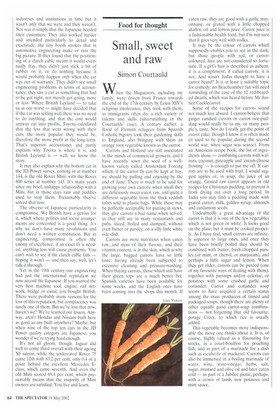Small, sweet and raw
Simon Courtauld
When the Huguenots, including my family, were driven from France towards the end of the 17th century by Louis XIV's religious intolerance, they took with them, as immigrants often do, a rich variety of talents and skills (silversmithing in the Courtaulds' case). A century earlier, a flood of Flemish refugees from Spanish Catholic bigotry took their gardening skills to England, also bringing with them an orange root vegetable known as the carrot.
Carrots and Holland are still associated in the minds of commercial growers: and I have recently sown the seed of a wellknown variety called Amsterdam Forcing which, if the carrot fly can be kept at bay, we should be pulling and enjoying by the end of June, There is much to be said for growing your own carrots: when small they are deliciously sweet eaten raw, and quite a different vegetable from the thick reddish tubes sold in plastic bags. While these may be perfectly acceptable for putting in stews, they give carrots a bad name when served, as they still are in many restaurants and pubs, sliced, boiled and dumped, without even butter or parsley, on a silly little white side-dish.
Carrots are most nutritious when eaten raw, and most of their flavour, and their vitamin content, is in the skin, which is why the large, bagged carrots have so little taste, having already been subjected to excessive cleaning and pressure-washing. When buying carrots, those which still have their green tops are a much better bet. Spanish varieties have been available for some weeks, and the English ones have been coming into the shops this month. If
eaten raw, they are good with a garlic mayonnaise, or grated with a little chopped shallot, oil and lemon juice. Carrot juice is a fashionable health food, but I'm not sure that it goes very well with vodka.
It may be the colour of carrots which supposedly enables you to see in the dark; but those people with red, or carrotcoloured, hair are not considered so fortunate. If a girl's hair is described as auburn, it is a compliment; if called carroty, it is not. And wasn't Judas thought to have a carrot beard? It is at least a suitable topic for comedy: no Beachcomber fan will need reminding of the case of the 12 red-bearded dwarfs, which was heard before Mr Justice Cocklecarrot.
Some of the recipes for carrots sound not much less absurd. I cannot believe that ginger candied carrots or carrot rice-pudding would really be to my, or many people's, taste. Nor do I really get the point of carrot cake, though I know it is often made (it used to be popular during the second world war, when sugar was scarce). From an American recipe book, the list of ingredients alone — combining carrots with walnuts, coconut, pineapple and 'cream-cheese frosting' — is enough to put me off. If carrots are to be used with fruit, I would suggest apples or, in soup, the juice of an orange. Grated raw carrot appears in old recipes for Christmas pudding, to prevent it from drying out over a long period. In India you may find a pudding made with grated carrot, milk, golden syrup, almonds and cardamom seeds.
Undoubtedly a great advantage of the carrot is that it is one of the few vegetables which is not green or white. It looks good on the plate; but it must be cooked properly. As I have said, small carrots are infinitely superior to large ones, and once they have been briefly boiled they should be combined with butter, fresh chopped parsley (or mint, or chervil, or marjoram), and perhaps a little sugar and lemon. When they get older, carrots can be pureed (one of my favourite ways of dealing with them), together with parsnips and/or celeriac, or potatoes with some crushed garlic and coriander. Carrot and coriander soup seems to have acquired a certain status among the mass producers of tinned and packaged soups, though there are plenty of other equally good carrot-soup combinations — not forgetting that old favourite, potage Crecy, to which rice is usually added.
This vegetable becomes more indispensable the more one thinks about it. It is, of course, highly valued as a flavouring for stocks, in a court-bouillon for poaching fish, and as part of a marinade for a dish such as escabeche of mackerel. Carrots can also be immersed in a boiling marinade of water, wine, wine-vinegar, herbs, salt, sugar, mustard and olive oil and later eaten cold — as part of a Jubilee picnic, perhaps, with a crown of lamb, new potatoes and mint sauce.














































































 Previous page
Previous page